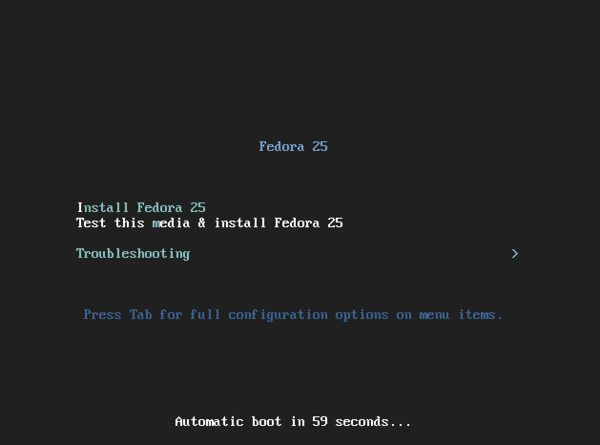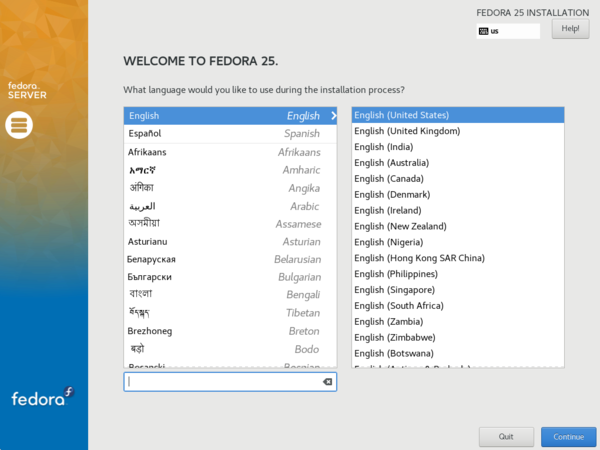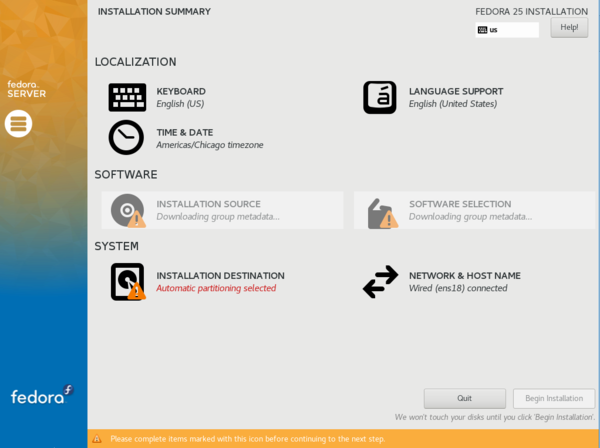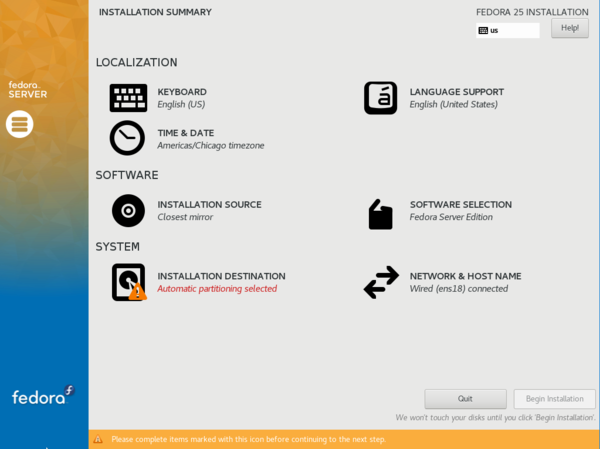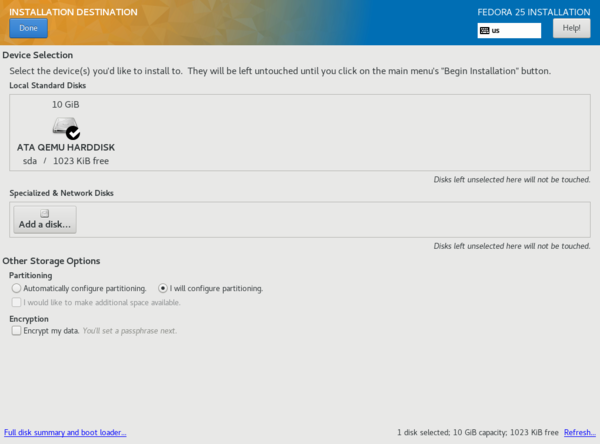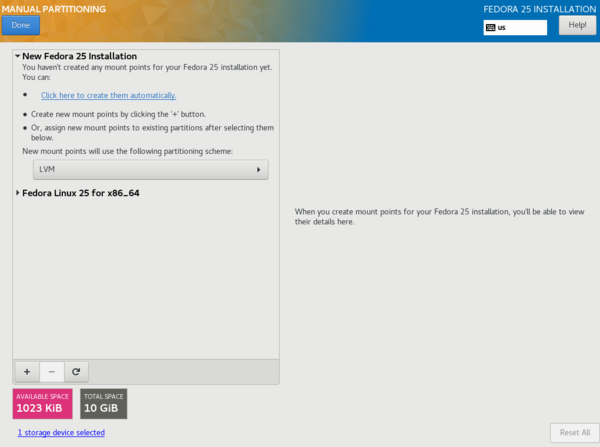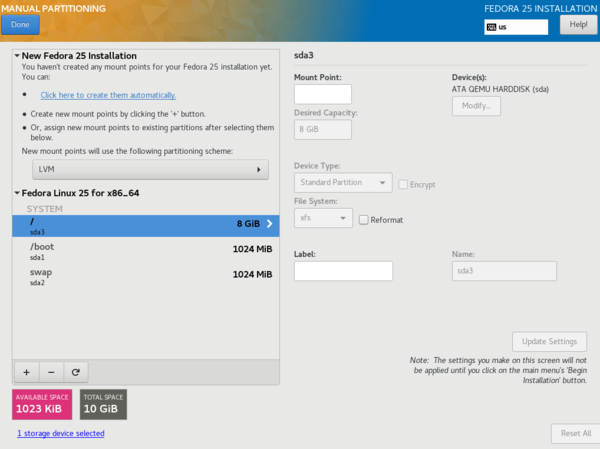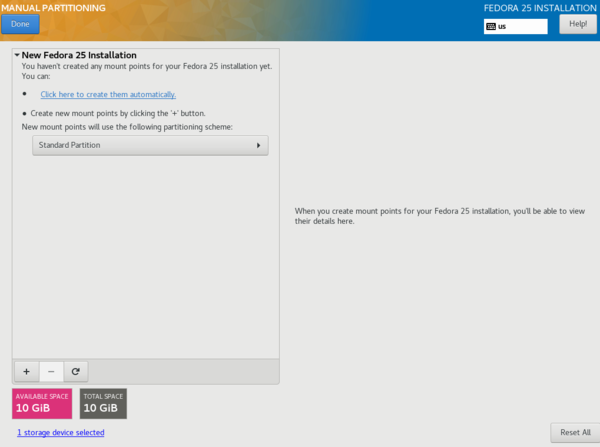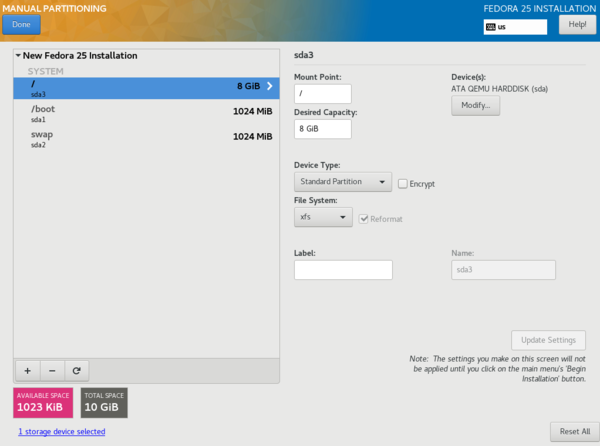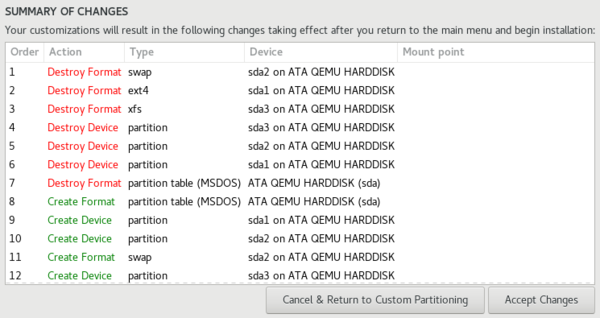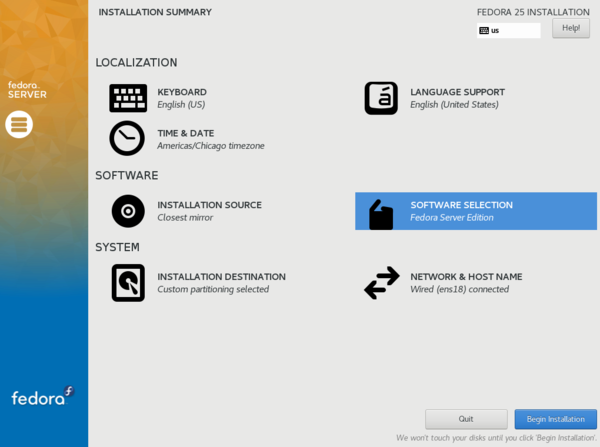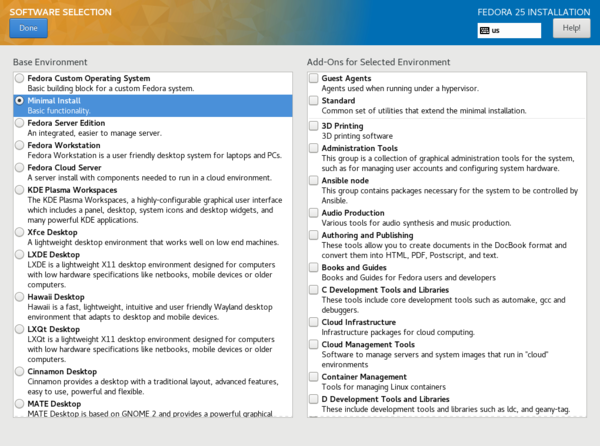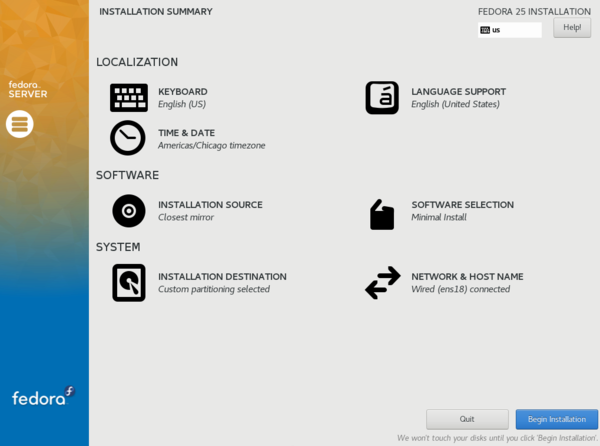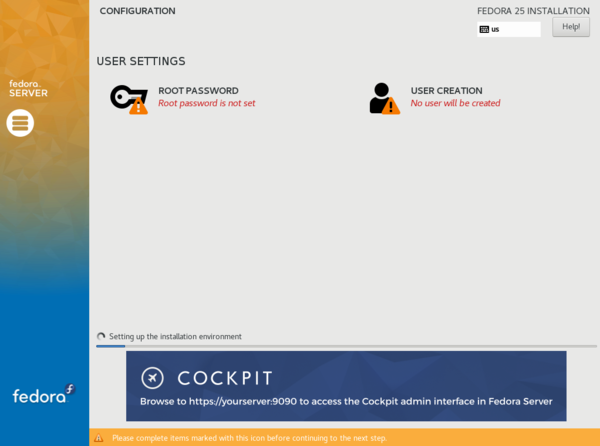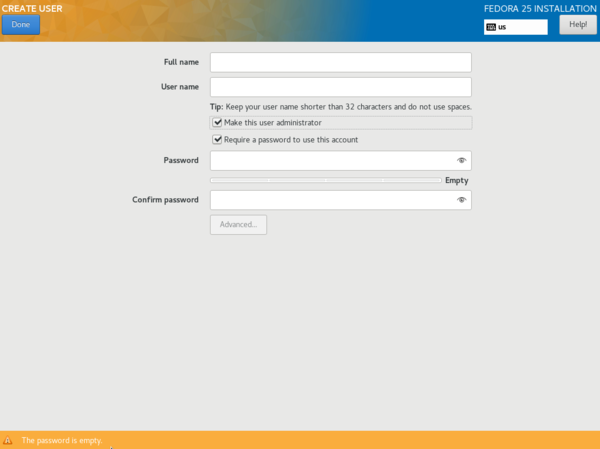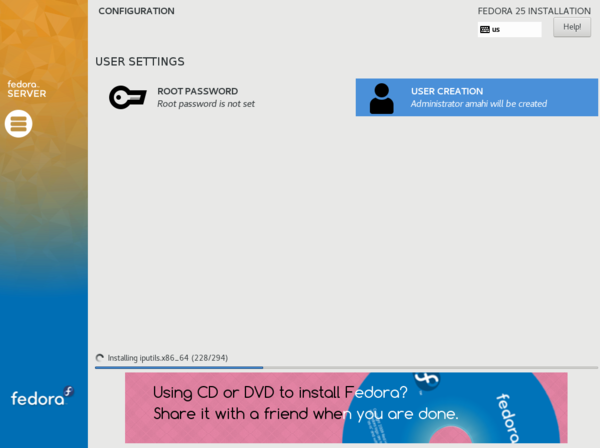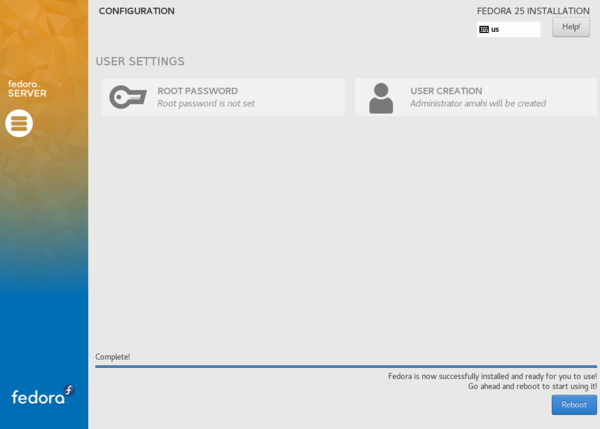Difference between revisions of "Amahi 10 Install"
| (6 intermediate revisions by 2 users not shown) | |||
| Line 1: | Line 1: | ||
| + | {{MessageBox| | ||
| + | backgroundcolor = #faa| | ||
| + | image =Warning.png| | ||
| + | heading =WARNING| | ||
| + | message = Amahi 10 for Fedora 25<br />Maintenance Support ONLY! | ||
| + | Please use a supported release!<br />}} | ||
__TOC__ | __TOC__ | ||
| Line 4: | Line 10: | ||
'''NOTES:''' | '''NOTES:''' | ||
* The only '''officially supported''' install media is Fedora 25 Server. | * The only '''officially supported''' install media is Fedora 25 Server. | ||
| − | * Ensure your system meets the [ | + | * Ensure your system meets the [http://docs.amahi.org/requirements.html minimum hardware requirements] for Amahi before proceeding. |
* 32-bit installs '''are not''' available nor supported in Amahi 10. | * 32-bit installs '''are not''' available nor supported in Amahi 10. | ||
* '''NOT ALL''' apps in previous Amahi versions are available for Amahi 10. Check the [https://www.amahi.org/apps App Store] before proceeding. | * '''NOT ALL''' apps in previous Amahi versions are available for Amahi 10. Check the [https://www.amahi.org/apps App Store] before proceeding. | ||
| Line 17: | Line 23: | ||
We recommend this method for a quick download and fast installation. | We recommend this method for a quick download and fast installation. | ||
| − | * Download the | + | * Download the [https://archives.fedoraproject.org/pub/archive/fedora/linux/releases/25/Server/x86_64/iso/Fedora-Server-netinst-x86_64-25-1.3.iso Fedora 25 Netinstall CD] for 64 bit (484MB). |
| − | |||
| − | |||
* Burn the ISO to CD/DVD (or [[USB Install|USB]]), insert the media into your server, and reboot the system. | * Burn the ISO to CD/DVD (or [[USB Install|USB]]), insert the media into your server, and reboot the system. | ||
| − | * These instructions below will guide you through the Fedora 25 Netinstall CD installation with screen shots and commentary. If you are not an advanced Linux user and know what you are doing, recommend you '''DO NOT''' deviate from the guidance. Click '''[ | + | * These instructions below will guide you through the Fedora 25 Netinstall CD installation with screen shots and commentary. If you are not an advanced Linux user and know what you are doing, recommend you '''DO NOT''' deviate from the guidance. Click '''[<Screenshot>]''' to show/hide the image. |
==Boot Screen== | ==Boot Screen== | ||
<ul> | <ul> | ||
<li>Select ''Install Fedora 25'' | <li>Select ''Install Fedora 25'' | ||
| − | <div class="mw-collapsible mw-collapsed" style="width:400px"> | + | <div class="mw-collapsible mw-collapsed" data-collapsetext="{{int:Screenshot}}" style="width:400px"> |
[[file:F25CD_SS0.PNG|600px]] | [[file:F25CD_SS0.PNG|600px]] | ||
</div><br></li> | </div><br></li> | ||
| Line 36: | Line 40: | ||
<ul> | <ul> | ||
<li>Choose desired language and select ''Continue'' | <li>Choose desired language and select ''Continue'' | ||
| − | <div class="mw-collapsible mw-collapsed" style="width:400px"> | + | <div class="mw-collapsible mw-collapsed" data-collapsetext="{{int:Screenshot}}" style="width:400px"> |
[[file:F25CD_SS1.PNG|600px]] | [[file:F25CD_SS1.PNG|600px]] | ||
</div><br></li> | </div><br></li> | ||
| Line 44: | Line 48: | ||
<ul> | <ul> | ||
<li>The '''INSTALLATION SUMMARY''' screen will appear. It may take a few minutes to finish ''Checking software dependencies'' | <li>The '''INSTALLATION SUMMARY''' screen will appear. It may take a few minutes to finish ''Checking software dependencies'' | ||
| − | <div class="mw-collapsible mw-collapsed" style="width:400px"> | + | <div class="mw-collapsible mw-collapsed" data-collapsetext="{{int:Screenshot}}" style="width:400px"> |
[[file:F25CD_SS2A.PNG|600px]] | [[file:F25CD_SS2A.PNG|600px]] | ||
</div><br></li> | </div><br></li> | ||
| Line 52: | Line 56: | ||
<li>Once complete, next choose ''INSTALLATION DESTINATION''. This is where you will select the disk drive to use. | <li>Once complete, next choose ''INSTALLATION DESTINATION''. This is where you will select the disk drive to use. | ||
| − | <div class="mw-collapsible mw-collapsed" style="width:400px"> | + | <div class="mw-collapsible mw-collapsed" data-collapsetext="{{int:Screenshot}}" style="width:400px"> |
[[file:F25CD_SS2B.PNG|600px]] | [[file:F25CD_SS2B.PNG|600px]] | ||
</div><br></li> | </div><br></li> | ||
| Line 62: | Line 66: | ||
<ul> | <ul> | ||
<li>Choose the disk drive you want to use for the Fedora installation. If you have more than one disk drive connected, '''DO NOT''' select them at this time. You will notice a ''check mark'' on the disk drive selected. Select ''I will configure partitioning'' and then choose ''Done''. | <li>Choose the disk drive you want to use for the Fedora installation. If you have more than one disk drive connected, '''DO NOT''' select them at this time. You will notice a ''check mark'' on the disk drive selected. Select ''I will configure partitioning'' and then choose ''Done''. | ||
| − | <div class="mw-collapsible mw-collapsed" style="width:400px"> | + | <div class="mw-collapsible mw-collapsed" data-collapsetext="{{int:Screenshot}}" style="width:400px"> |
[[file:F25CD_SS3A.PNG|600px]] | [[file:F25CD_SS3A.PNG|600px]] | ||
</div><br></li> | </div><br></li> | ||
| Line 69: | Line 73: | ||
<ul> | <ul> | ||
<li> You should see the existing partition about half way down the screen. | <li> You should see the existing partition about half way down the screen. | ||
| − | <div class="mw-collapsible mw-collapsed" style="width:400px"> | + | <div class="mw-collapsible mw-collapsed" data-collapsetext="{{int:Screenshot}}" style="width:400px"> |
[[file:F25CD_SS3B.PNG|600px]] | [[file:F25CD_SS3B.PNG|600px]] | ||
</div></li> | </div></li> | ||
<li>Choose it to expand and display the existing partitions for deletion. Select the first partition in the list followed by the minus (-) sign. | <li>Choose it to expand and display the existing partitions for deletion. Select the first partition in the list followed by the minus (-) sign. | ||
| − | <div class="mw-collapsible mw-collapsed" style="width:400px"> | + | <div class="mw-collapsible mw-collapsed" data-collapsetext="{{int:Screenshot}}" style="width:400px"> |
[[file:F25CD_SS3C.PNG|600px]] | [[file:F25CD_SS3C.PNG|600px]] | ||
</div></li> | </div></li> | ||
<li> When prompted Are you sure you want to delete all the data on ..., choose Delete It. | <li> When prompted Are you sure you want to delete all the data on ..., choose Delete It. | ||
| − | <div class="mw-collapsible mw-collapsed" style="width:400px"> | + | <div class="mw-collapsible mw-collapsed" data-collapsetext="{{int:Screenshot}}" style="width:400px"> |
[[file:F25CD_SS3D.PNG|400px]] | [[file:F25CD_SS3D.PNG|400px]] | ||
</div></li> | </div></li> | ||
| Line 84: | Line 88: | ||
<li>Ensure the ''New mount points will use the following partitioning scheme:'' is changed to reflect '''Standard partition'''. Then select ''Click here to create them automatically''. | <li>Ensure the ''New mount points will use the following partitioning scheme:'' is changed to reflect '''Standard partition'''. Then select ''Click here to create them automatically''. | ||
| − | <div class="mw-collapsible mw-collapsed" style="width:400px"> | + | <div class="mw-collapsible mw-collapsed" data-collapsetext="{{int:Screenshot}}" style="width:400px"> |
[[file:F25CD_SS3E.PNG|600px]] | [[file:F25CD_SS3E.PNG|600px]] | ||
</div><br></li> | </div><br></li> | ||
<li>The disk drive partition should look similar to this setup. For most users, then default partitioning scheme used will suffice. However, you can manually change it using the hard drive partition scheme documentation as a guide. Once complete, choose ''Done'' | <li>The disk drive partition should look similar to this setup. For most users, then default partitioning scheme used will suffice. However, you can manually change it using the hard drive partition scheme documentation as a guide. Once complete, choose ''Done'' | ||
| − | <div class="mw-collapsible mw-collapsed" style="width:400px"> | + | <div class="mw-collapsible mw-collapsed" data-collapsetext="{{int:Screenshot}}" style="width:400px"> |
[[file:F25CD_SS3F.PNG|600px]] | [[file:F25CD_SS3F.PNG|600px]] | ||
</div><br></li> | </div><br></li> | ||
<li>You will now see '''SUMMARY OF CHANGES''' to the disk drive. Choose ''Accept Changes'' | <li>You will now see '''SUMMARY OF CHANGES''' to the disk drive. Choose ''Accept Changes'' | ||
| − | <div class="mw-collapsible mw-collapsed" style="width:400px"> | + | <div class="mw-collapsible mw-collapsed" data-collapsetext="{{int:Screenshot}}" style="width:400px"> |
[[file:F25CD_SS3G.PNG|600px]] | [[file:F25CD_SS3G.PNG|600px]] | ||
</div><br></li> | </div><br></li> | ||
| Line 102: | Line 106: | ||
<ul> | <ul> | ||
<li>Next on the '''INSTALLATION SUMMARY''', select ''SOFTWARE SELECTION'' | <li>Next on the '''INSTALLATION SUMMARY''', select ''SOFTWARE SELECTION'' | ||
| − | <div class="mw-collapsible mw-collapsed" style="width:400px"> | + | <div class="mw-collapsible mw-collapsed" data-collapsetext="{{int:Screenshot}}" style="width:400px"> |
[[file:F25CD_SS4A.PNG|600px]] | [[file:F25CD_SS4A.PNG|600px]] | ||
</div><br></li> | </div><br></li> | ||
<li>Select ''Minimal Install'' and then choose ''Done'' | <li>Select ''Minimal Install'' and then choose ''Done'' | ||
| − | <div class="mw-collapsible mw-collapsed" style="width:400px"> | + | <div class="mw-collapsible mw-collapsed" data-collapsetext="{{int:Screenshot}}" style="width:400px"> |
[[file:F25CD_SS4B.PNG|600px]] | [[file:F25CD_SS4B.PNG|600px]] | ||
</div><br></li> | </div><br></li> | ||
| Line 115: | Line 119: | ||
<ul> | <ul> | ||
<li>Back to the '''INSTALLATION SUMMARY''' and ready to begin installation. Select ''Begin Installation'' | <li>Back to the '''INSTALLATION SUMMARY''' and ready to begin installation. Select ''Begin Installation'' | ||
| − | <div class="mw-collapsible mw-collapsed" style="width:400px"> | + | <div class="mw-collapsible mw-collapsed" data-collapsetext="{{int:Screenshot}}" style="width:400px"> |
[[file:F25CD_SS5.PNG|600px]] | [[file:F25CD_SS5.PNG|600px]] | ||
</div><br></li> | </div><br></li> | ||
| Line 123: | Line 127: | ||
<ul> | <ul> | ||
<li>Installation has begun and we need to create the initial user. '''DO NOT''' set the root password. | <li>Installation has begun and we need to create the initial user. '''DO NOT''' set the root password. | ||
| − | <div class="mw-collapsible mw-collapsed" style="width:400px"> | + | <div class="mw-collapsible mw-collapsed" data-collapsetext="{{int:Screenshot}}" style="width:400px"> |
[[file:F25CD_SS6A.PNG|600px]] | [[file:F25CD_SS6A.PNG|600px]] | ||
</div><br></li> | </div><br></li> | ||
<li>You '''MUST''' create the initial user and password (This will be your HDA Login, also called the First Admin User). Ensure you select ''Make this user administrator'' check box. Once complete, choose ''Done''. Note that a weak password may require you to select ''Done'' twice. | <li>You '''MUST''' create the initial user and password (This will be your HDA Login, also called the First Admin User). Ensure you select ''Make this user administrator'' check box. Once complete, choose ''Done''. Note that a weak password may require you to select ''Done'' twice. | ||
| − | <div class="mw-collapsible mw-collapsed" style="width:400px"> | + | <div class="mw-collapsible mw-collapsed" data-collapsetext="{{int:Screenshot}}" style="width:400px"> |
[[file:F25CD_SS6B.PNG|600px]] | [[file:F25CD_SS6B.PNG|600px]] | ||
</div><br></li> | </div><br></li> | ||
| Line 136: | Line 140: | ||
<ul> | <ul> | ||
<li>Now all of the configuration steps are complete. Sit back and watch the progress. | <li>Now all of the configuration steps are complete. Sit back and watch the progress. | ||
| − | <div class="mw-collapsible mw-collapsed" style="width:400px"> | + | <div class="mw-collapsible mw-collapsed" data-collapsetext="{{int:Screenshot}}" style="width:400px"> |
[[file:F25CD SS7.PNG|600px]] | [[file:F25CD SS7.PNG|600px]] | ||
</div><br></li> | </div><br></li> | ||
| Line 144: | Line 148: | ||
<ul> | <ul> | ||
<li>Installation is complete. Choose ''Reboot'' and remove the installation media. | <li>Installation is complete. Choose ''Reboot'' and remove the installation media. | ||
| − | <div class="mw-collapsible mw-collapsed" style="width:400px"> | + | <div class="mw-collapsible mw-collapsed" data-collapsetext="{{int:Screenshot}}" style="width:400px"> |
[[file:F25CD SS8.PNG|600px]] | [[file:F25CD SS8.PNG|600px]] | ||
</div><br></li></ul> | </div><br></li></ul> | ||
| Line 153: | Line 157: | ||
<ul> | <ul> | ||
<li>When you reboot you will see a black screen with no graphics and a "localhost login" text prompt. Login into that that console directly with the user and password you created in the Fedora 25 installation. (You can also use SSH to login remotely from a client if you know how) | <li>When you reboot you will see a black screen with no graphics and a "localhost login" text prompt. Login into that that console directly with the user and password you created in the Fedora 25 installation. (You can also use SSH to login remotely from a client if you know how) | ||
| − | <div class="mw-collapsible mw-collapsed" style="width:400px"> | + | <div class="mw-collapsible mw-collapsed" data-collapsetext="{{int:Screenshot}}" style="width:400px"> |
[[file:A10_SS1.PNG|450px]] | [[file:A10_SS1.PNG|450px]] | ||
</div><br><br> | </div><br><br> | ||
| Line 190: | Line 194: | ||
* Your server will boot with the static IP you pre-configured in the Amahi control panel | * Your server will boot with the static IP you pre-configured in the Amahi control panel | ||
| − | * This is a headless server, therefore it will boot to a text console. There is no desktop user interface. | + | * This is a headless server, therefore it will boot to a text console. There is no desktop user interface. '''Installing the Desktop (e.g. GNOME) interface will break DNS/DHCP and make the HDA as an unsuitable network server''' [[Amahi_8_Troubleshooting#Virtualization_Stack_Breaks_DNS.2FDHCP_Server|(details)]] |
* It's strongly recommended you follow the [[transition to Amahi]] HDA guide to get your network fully working properly | * It's strongly recommended you follow the [[transition to Amahi]] HDA guide to get your network fully working properly | ||
* You can verify if the dashboard is available by accessing it from any client using the IP address of your server '''<nowiki>http://IPADDRESS/</nowiki>''' or '''<nowiki>http://hda/</nowiki>''' (in most Windows clients this works even without DNS from your HDA) | * You can verify if the dashboard is available by accessing it from any client using the IP address of your server '''<nowiki>http://IPADDRESS/</nowiki>''' or '''<nowiki>http://hda/</nowiki>''' (in most Windows clients this works even without DNS from your HDA) | ||
Latest revision as of 01:20, 25 July 2019
| WARNING | |
|---|---|
| Amahi 10 for Fedora 25 Maintenance Support ONLY! Please use a supported release! |
Contents
NOTES:
- The only officially supported install media is Fedora 25 Server.
- Ensure your system meets the minimum hardware requirements for Amahi before proceeding.
- 32-bit installs are not available nor supported in Amahi 10.
- NOT ALL apps in previous Amahi versions are available for Amahi 10. Check the App Store before proceeding.
- You must install Fedora 25 Server prior to installing Amahi 10.
For assistance, visit the Amahi Forums or live support on the Amahi IRC channel.
Install Fedora 25
There are two ways to install Fedora: Minimal (CD), so-called Netinstall, which is recommended, and the Full (DVD) install for cases that need additional hardware support.
We recommend this method for a quick download and fast installation.
- Download the Fedora 25 Netinstall CD for 64 bit (484MB).
- Burn the ISO to CD/DVD (or USB), insert the media into your server, and reboot the system.
- These instructions below will guide you through the Fedora 25 Netinstall CD installation with screen shots and commentary. If you are not an advanced Linux user and know what you are doing, recommend you DO NOT deviate from the guidance. Click [<Screenshot>] to show/hide the image.
Boot Screen
- Select Install Fedora 25
Language Selection
- Choose desired language and select Continue
Installation Summary
- The INSTALLATION SUMMARY screen will appear. It may take a few minutes to finish Checking software dependencies
- Change the KEYBOARD or TIME & DATE to match your locale if needed.
- Verify NETWORK & HOST NAME indicates connected. Don't make any changes unless you are sure of what you are doing.
- Once complete, next choose INSTALLATION DESTINATION. This is where you will select the disk drive to use.
Disk Drive Setup
- Choose the disk drive you want to use for the Fedora installation. If you have more than one disk drive connected, DO NOT select them at this time. You will notice a check mark on the disk drive selected. Select I will configure partitioning and then choose Done.
- Should you have existing partitions on the disk drive you will be using for the Fedora 25 installation, they will have to be removed.
- You should see the existing partition about half way down the screen.
- Choose it to expand and display the existing partitions for deletion. Select the first partition in the list followed by the minus (-) sign.
- When prompted Are you sure you want to delete all the data on ..., choose Delete It.
- Repeat the previous two steps until all the existing partitions on the disk drive are gone.
- Ensure the New mount points will use the following partitioning scheme: is changed to reflect Standard partition. Then select Click here to create them automatically.
- The disk drive partition should look similar to this setup. For most users, then default partitioning scheme used will suffice. However, you can manually change it using the hard drive partition scheme documentation as a guide. Once complete, choose Done
- You will now see SUMMARY OF CHANGES to the disk drive. Choose Accept Changes
Software Selection
- Next on the INSTALLATION SUMMARY, select SOFTWARE SELECTION
- Select Minimal Install and then choose Done
Begin Installation
- Back to the INSTALLATION SUMMARY and ready to begin installation. Select Begin Installation
Initial User Creation
- Installation has begun and we need to create the initial user. DO NOT set the root password.
- You MUST create the initial user and password (This will be your HDA Login, also called the First Admin User). Ensure you select Make this user administrator check box. Once complete, choose Done. Note that a weak password may require you to select Done twice.
Installation Progress
- Now all of the configuration steps are complete. Sit back and watch the progress.
Installation Complete
- Installation is complete. Choose Reboot and remove the installation media.
Install Amahi 10
Next, we will install Amahi 10 proper on top of Fedora 25.
- When you reboot you will see a black screen with no graphics and a "localhost login" text prompt. Login into that that console directly with the user and password you created in the Fedora 25 installation. (You can also use SSH to login remotely from a client if you know how)
- NOTE: Passwords do not echo characters on the screen.
- You need to obtain an install code (denoted YOUR-INSTALL-CODE below) from the Amahi control panel after configuring a profile for the system you are installing, with proper network configuration for your network.
- From text console or using SSH (logged in with the user created in the Fedora 25 installation), become root for the Amahi installation. When prompted for a password, it's your user password you set in the Fedora 25 install.
sudo su -
- After that, type these three separate commands (one per line) in the console:
rpm -Uvh http://f25.amahi.org/noarch/hda-release-10.0.0-1.noarch.rpm dnf -y install hda-ctl hda-install YOUR-INSTALL-CODE
What this does is installs the Amahi F25 repo, gets the mariadb base packages to avoid dependency conflicts, and installs base Amahi packages (that part should install several packages).
If there are no errors, install Amahi (replace YOUR-INSTALL-CODE above with install code you got when creating a profile at your Amahi control panel).
If all goes well, it should tell you to reboot. Go ahead and reboot!
Once it comes back from the reboot, you should have a fully functional home server using the IP address you set up in your network!
Next you need to transition your network to use it!
Transitioning to your Amahi server
Once installed, you will want to transition your network to using your Amahi server. Here are some of the things you should know:
- Your server will boot with the static IP you pre-configured in the Amahi control panel
- This is a headless server, therefore it will boot to a text console. There is no desktop user interface. Installing the Desktop (e.g. GNOME) interface will break DNS/DHCP and make the HDA as an unsuitable network server (details)
- It's strongly recommended you follow the transition to Amahi HDA guide to get your network fully working properly
- You can verify if the dashboard is available by accessing it from any client using the IP address of your server http://IPADDRESS/ or http://hda/ (in most Windows clients this works even without DNS from your HDA)
- The first time it will initialize, ask you to login, and enter a dashboard password.
- Once you reach your dashboard, you should create shares as needed, add more drives, install apps, etc., etc.
- Optionally refer to Greyhole to install/configure storage pooling.
Troubleshooting
Visit the troubleshooting page if you find yourself in trouble.
Reference
Refer to the HDA Admin How To page for Amahi Server administrator guidance.
Go back to Amahi Docs page.
